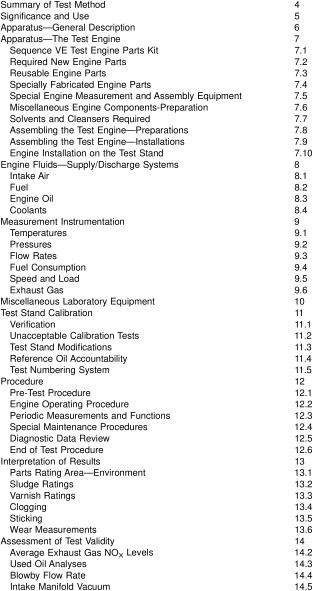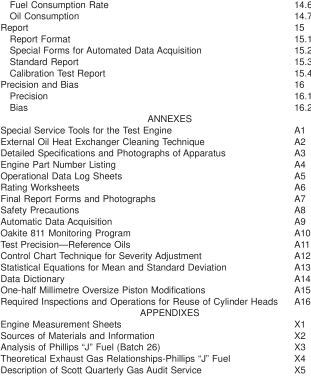1. Scope
1.1 This test method is commonly referred to as the Sequence VE test and has been correlated with vehicles used in stop-and-go service prior to 1988, particularly with regard to sludge and varnish formation and valve train wear. It is one of the test methods required to evaluate oils intended to satisfy the API SJ performance category.
1.2 The values stated in either inch-pound units or SI units are to be regarded separately as the standard. Within the text, the SI units are shown in parentheses when combined with inch-pound units. Some of the figures and forms have identical numerical designations, but with the letter M following the numerical designation: these are alternative figures and forms that contain SI units.
1.3 This standard does not purport to address all of the safety concerns, if any, associated with its use. It is the responsibility of the user of this standard to establish appropriate safety and health practices and determine the applicability of regulatory limitations prior to use. Specific precautionary statements are given in 7.7, 7.8.9.6, 7.8.13, 7.10.2, 7.10.3.2(c), 8.3.4.2, 8.4.4.3, 8.4.5.2, 9.3.4.4, 9.6.1.2, 12.1.1.5, 12.1.4.5, 12.2.1, 12.2.1.5, Fig. A3.6, and Annex A8.
1.4 Table of Contents:



2. Referenced Documents
2.1 ASTM Standards:
D86 Test Method for Distillation of Petroleum Products
D287 Test Method forAPI Gravity of Crude Petroleum and Petroleum Products (Hydrometer Method)
D323 Test Method for Vapor Pressure of Petroleum Products (Reid Method)
D381 Test Method for Existent Gum in Fuels by Jet Evaporation
D445 Test Method for Kinematic Viscosity of Transparent and Opaque Liquids ( the Calculation of Dynamic Viscosity)
D525 Test Method for Oxidation Stability of Gasoline (Induction Period Method)
D873 Test Method for Oxidation Stability of Aviation Fuels (Potential Residue Method)
D893 Test Method for Insolubles in Used Lubricating Oils
D1266 Test Method for Sulfur in Petroleum Products (Lamp Method)
D3237 Test Method for Lead in Gasoline by Atomic Absorption Spectrometry
D3525 Test Method for Gasoline Diluent in Used Gasoline Engine Oils by Gas Chromatography
D3606 Test Method for the Determination of Benzene and Toluene in Finished Motor and Aviation Gasoline by Gas Chromatography
D4057 Practice for Manual Sampling of Petroleum and Petroleum Products
D4175 Terminology Relating to Petroleum, Petroleum Products, and Lubricants
D4485 Specification for Performance of Engine Oils
D5134 Test Method for Detailed Analysis of Petroleum Naphthas Through n-Nonane by Capillary Gas Chromatography
G 40 Terminology Relating to Wear and Erosion
2.2 SAE Standards:
SAE J254 Instrumentation and Techniques for Exhaust Gas Emissions Measurement
2.3 ANSI Standard:
MC96.1 Temperature Measurement - Thermocouples
2.4 Coordinating Research Council:
CRC Sludge Rating Manual (CRC Manual No. 12)
CRC Varnish Rating Manual (CRC Manual No. 14)
CRC Techniques for Valve Rating (CRC Manual No. 16)
3. Terminology
3.1 Definitions:
3.1.1 air-fuel ratio, n - in internal combustion engines, the mass ratio of air-to-fuel in the mixture being induced into the combustion chambers.
3.1.1.1 Discussion - In this test method, air-fuel ratio is controlled indirectly by exhaust gas analysis for CO and O2 contents. During Stages I and II, O2 is the primary determinant, while CO is the primary determinant in Stage III.
3.1.2 blowby, n - in internal combustion engines, the combustion products and unburned air/fuel mixture that enter the crankcase.
3.1.3 cold-stuck piston ring, n - in internal combustion engines, one that is stuck when the piston and ring are at room temperature, but inspection shows that it was free during engine operation.
3.1.3.1 Discussion - A cold-stuck piston ring cannot be moved with moderate finger pressure. It is characterized by a polished face over its entire circumference, indicating essentially no blowby passed over the outside of the ring during engine operation.
3.1.4 debris, n - in internal combustion engines, solid contaminant materials unintentionally introduced into the engine or resulting from wear.
3.1.4.1 Discussion - Examples include such things as gasket material, silicone sealer, towel threads, and metal particles.
3.1.5 free piston ring, n - in internal combustion engines, a piston ring that will fall in its groove under its own weight when the piston, with the ring in a horizontal plane, is turned 90° (putting the ring in a vertical plane).
3.1.5.1 Discussion - A slight touch to overcome static friction is permissible.
3.1.6 hot-stuck piston ring, n - in internal combustion engines, a piston ring that is stuck when the piston and ring are at room temperature, and inspection shows that it was stuck during engine operation.
3.1.6.1 Discussion - The portion of the ring that is stuck cannot be moved with moderate finger pressure. A hot-stuck ring is characterized by varnish or carbon across some portion of its face, indicating that portion of the ring was not contacting the cylinder wall during engine operation.
3.1.7 knock, n - in a spark ignition engine, abnormal combustion, often producing audible sound, caused by autoignition of the air/fuel mixture.
3.1.8 scoring, n - in tribology, a severe form of wear characterized by the formation of extensive grooves and scratches in the direction of sliding.
3.1.9 scuff, scuffing, n - in lubrication, damage caused by instantaneous localized welding between surfaces in relative motion that does not result in immobilization of the parts.
3.1.10 sludge, n - in internal combustion engines, a deposit, principally composed of insoluble resins and oxidation products from fuel combustion and the lubricant, that does not drain from engine parts but can be removed by wiping with a cloth.
3.1.11 tight piston ring, n - in internal combustion engines, a piston ring that will not fall in its groove under its own weight when the piston, with the ring in a horizontal plane, is turned 90° (putting the ring in a vertical plane); by subsequent application of moderate finger pressure, the ring will be displaced.
3.1.12 varnish, n - in internal combustion engines, a hard, dry, generally lustrous deposit that can be removed by solvents but not by wiping with a cloth.
3.1.13 wear, n - the loss of material from, or relocation of material on, a surface.
3.1.13.1 Discussion - Wear generally occurs between two surfaces moving relative to each other, and is the result of mechanical or chemical action or by a combination of mechanical and chemical actions.
3.2 Definitions of Terms Specific to This Standard:
3.2.1 clogging, n - the restriction of a flow path due to the accumulation of debris along the flow path boundaries.
3.2.2 closed-loop lambda control system, n - one that functions by feeding back a direct measurement of lambda through a fully closed loop, and uses the measurement to alter the fuel input by changing the fuel injector pulse width.
3.2.3 enrichment, n - in internal combustion engine operation, a fuel consumption rate in excess of that which would achieve a stoichiometric fuel-to-air ratio.
3.2.3.1 Discussion - Enrichment is usually indicated by elevated CO levels and can also be detected with an extended range air/fuel ratio sensor.
3.2.4 lambda, n - the ratio of actual air mass induced, during engine operation, divided by the theoretical air mass requirement at the stoichiometric air-fuel ratio for the given fuel.
3.2.5 open loop lambda control system, n - one that utilizes manual adjustment of the fuel injector pulse width to alter lambda based on manual measurement of exhaust gas CO and O2 content.
3.2.6 low-temperature, light-duty conditions, n - indicative of engine oil and coolant temperatures that average below normal warmed-up temperatures, and engine speeds and power outputs that average below those encountered in typical highway driving.
3.2.7 ramping, n - the prescribed rate of change of a variable when one set of operating conditions is changed to another set of operating conditions.



